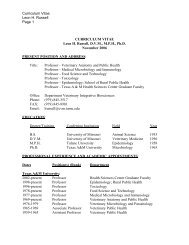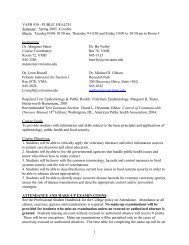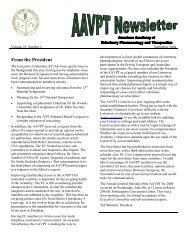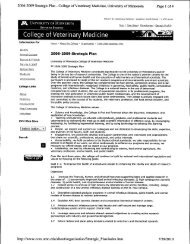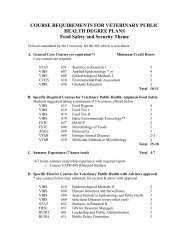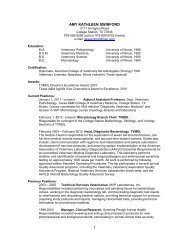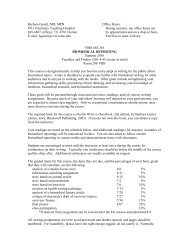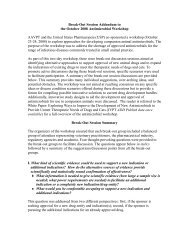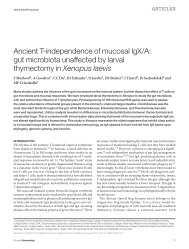Download PDF - College of Veterinary Medicine - Texas A&M ...
Download PDF - College of Veterinary Medicine - Texas A&M ...
Download PDF - College of Veterinary Medicine - Texas A&M ...
You also want an ePaper? Increase the reach of your titles
YUMPU automatically turns print PDFs into web optimized ePapers that Google loves.
Faculty/Staff Focus<br />
<strong>Texas</strong> A&M researchers unlock Quarter Horse genome<br />
The American Quarter Horse originated<br />
in the early colonial era and is<br />
now one <strong>of</strong> the most popular breeds in<br />
the nation. The journal BMC Genomics<br />
recently published a collaborative study<br />
by researchers at the <strong>Texas</strong> A&M University<br />
<strong>College</strong> <strong>of</strong> <strong>Veterinary</strong> <strong>Medicine</strong><br />
& Biomedical Sciences (CVM), <strong>Texas</strong><br />
A&M <strong>College</strong> <strong>of</strong> Agriculture and Life<br />
Sciences, and the AgriLife Genomics<br />
and Bioinformatics Center that<br />
sequenced the first Quarter Horse genome—unlocking<br />
the secrets <strong>of</strong> what<br />
makes this breed so distinctive.<br />
Genome sequencing is not a new<br />
science, but advances in sequencing<br />
technology, <strong>of</strong>ten referred to as nextgeneration<br />
sequencing, have made it<br />
easier and less expensive to sequence<br />
the genome <strong>of</strong> an individual, which<br />
then can be analyzed for clues causing<br />
genetic disorders and distinctive traits.<br />
The <strong>Texas</strong> A&M Quarter Horse is the<br />
first horse to be sequenced using nextgeneration<br />
sequencing technology.<br />
“Genome sequencing aids our study<br />
<strong>of</strong> normal and abnormal genetic variation,”<br />
said Dr. Scott Dindot, assistant<br />
pr<strong>of</strong>essor in the Department <strong>of</strong> <strong>Veterinary</strong><br />
Pathobiology at the CVM. “This<br />
project is important because it is a start<br />
toward understanding what genetic<br />
factors make breeds unique, and what<br />
56 • CVM Today • Winter 2012<br />
mutations may play a role in preventing<br />
or diagnosing disease.<br />
Dr. Noah Cohen, pr<strong>of</strong>essor in the<br />
Department <strong>of</strong> Large Animal Clinical<br />
Sciences at the CVM and collaborator<br />
in the study, underscored the importance<br />
<strong>of</strong> the role genetic<br />
variation plays in disease.<br />
“This study represents<br />
a valuable contribution to<br />
our understanding <strong>of</strong> genetic<br />
variation in horses,”<br />
Cohen said, “including<br />
efforts to study the relationship<br />
between genetic<br />
variation and susceptibility<br />
to important diseases in<br />
Quarter Horses and other<br />
breeds.”<br />
The first horse genome to be<br />
sequenced and assembled, that <strong>of</strong> a<br />
Thoroughbred mare, was completed<br />
by a large international consortium.<br />
This reference assembly was used to<br />
map the Quarter Horse genome and to<br />
identify differences in genetic information<br />
between the two horses. The<br />
sequence data from the project was<br />
made available publicly for researchers<br />
interested in equine genetics.<br />
“The horse used in the study, a mare<br />
named Sugar, is the descendant <strong>of</strong> key<br />
foundation sires in the Quarter Horse<br />
Dr. Scott Dindot with Sugar, the horse used to sequence the American Quarter Horse genome.<br />
breed,” Dindot said. “We were able to<br />
identify several genetic variants in this<br />
mare, both good and bad, known to<br />
be common among Quarter Horses.<br />
Results from this study have increased<br />
our knowledge <strong>of</strong> genetic variation in<br />
“Results from this study have<br />
increased our knowledge<br />
<strong>of</strong> genetic variation in horses<br />
three- to four-fold...”<br />
~ Dr. Scott Dindot<br />
horses three- to four-fold, and proved<br />
that through collaborations such as<br />
this, we can one day apply this state<strong>of</strong>-the-art<br />
technology to identify and<br />
possibly to manage genetic disorders<br />
not only in horses but also in other<br />
species.”<br />
The genome sequence <strong>of</strong> a Quarter<br />
Horse has the potential to have<br />
a tremendous impact on the equine<br />
industry, as the American Quarter<br />
Horse Association represents the largest<br />
breed registry in the United States.<br />
The information from this study may<br />
lead to improvements in performance<br />
in horses, and facilitate the management<br />
<strong>of</strong> horse health everywhere.<br />
“Many diseases and syndromes are<br />
the result <strong>of</strong> genetic variation,” said Dr.<br />
Jason Sawyer, <strong>Texas</strong> AgriLife Research<br />
scientist and associate pr<strong>of</strong>essor <strong>of</strong><br />
animal science at the CVM. “Perhaps<br />
more importantly, the ability to combat<br />
infectious diseases may be greatly<br />
impacted by the underlying genome<br />
and the variation that arises during recombination.<br />
This study has identified<br />
areas <strong>of</strong> variation that may play a role<br />
in the health and disease resistance <strong>of</strong><br />
horses. While more research must be<br />
done to specifically identify desirable<br />
and beneficial variants, this study has<br />
set the stage to enable those future<br />
studies.”<br />
Funding for the study was provided<br />
by the G. Willard and Ginger Pool<br />
Equine Teaching and Research Endowment,<br />
the Link Equine Research<br />
Endowment, <strong>Texas</strong> A&M AgriLife Research,<br />
the <strong>Texas</strong> A&M Department <strong>of</strong><br />
Animal Science, and the Department<br />
<strong>of</strong> <strong>Veterinary</strong> Pathobiology.




